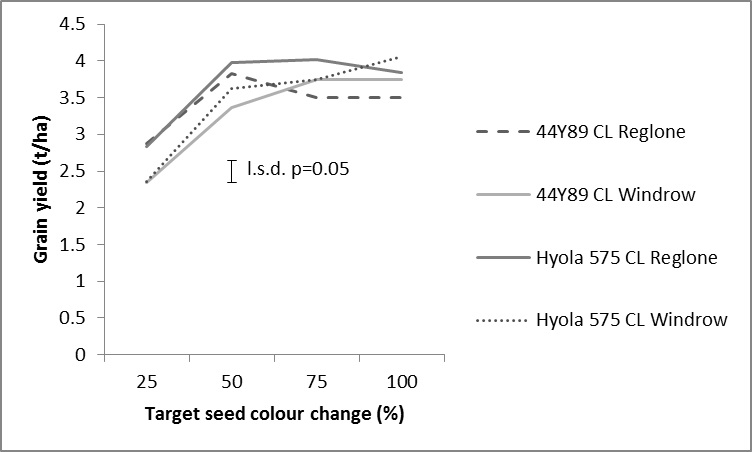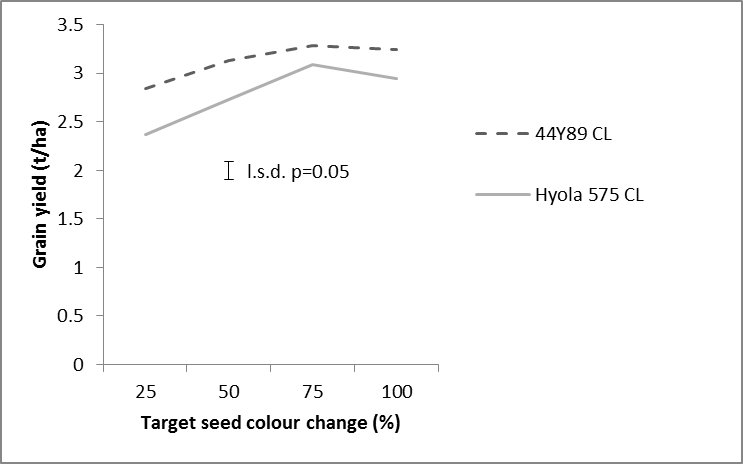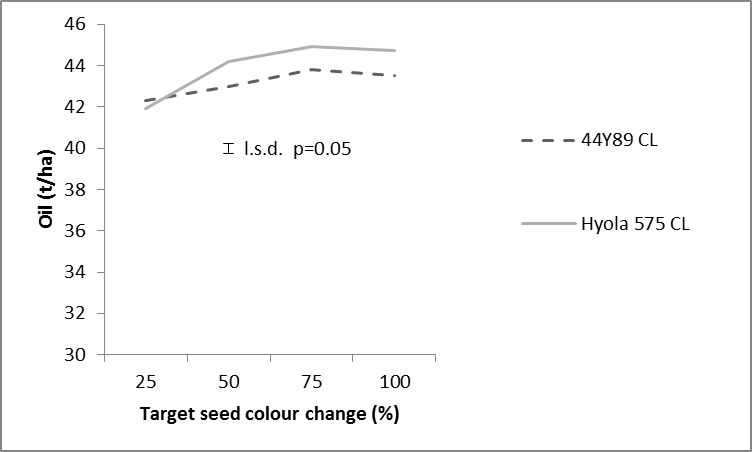A snapshot of results from year 1 trials of canola harvest management in northern NSW
Author: Leigh Jenkins, Rick Graham, Rohan Brill, Rod Bambach and Don McCaffery (NSW DPI) | Date: 20 Jul 2016
Take home message
The early application of harvest treatments reduced grain yield and oil concentration at Tamworth (Reglone and Windrow) and Trangie (Windrow only) in 2015. There were negative effects on both yield and oil even at the 50% target SCC timing at both sites. This may have been expected at Tamworth as Hyola 575 CL was only at 27% SCC when the treatments were applied. At Trangie, there was a yield reduction in both Hyola 575 CL and 44Y89 CL when their actual SCC (averaged across the plant) was beyond 50%. This may have been due to the method of measuring SCC, as the branches were much slower to mature than the main stems. This data suggests that seed colour change should be measured on a whole plant basis, not just on a main stem basis. More attention should be given to branches where they are likely to contribute to a large proportion of grain yield.
These experiments are being repeated in 2016 to validate or challenge the initial findings from the first year of trials in 2015.
Introduction
Windrowing has been a traditional and common practice for harvest management of canola in Australia. There have been two main reasons for this:- To reduce shattering losses incurred from storm and wind damage in ripe standing crops and/or during the harvest operation;
- To ‘even up’ and accelerate the grain ripening process, which can widen harvest windows and improve logistics.
Recently, late non-selective weed control has also been implemented with the windrowing operation.
Current industry guidelines recommend that canola is ready to windrow when 40-60% of seeds on the primary (main) stem have changed colour from green to red, brown or black, which is when seed moisture content is in the range of 35-45%.
The progression of seed colour change can be rapid in northern NSW and there is a need to balance the logistics of windrowing large areas of canola with optimising crop growth stage for yield potential. Research commenced in 2015 as a component of the GRDC co-funded ‘Optimised Canola Profitability’ project, to determine the relationship between seed colour change and grain yield and oil concentration. This will ultimately help growers make sound decisions on canola harvest management in the northern grains region, and potentially across Australia.
2015 experiments
In 2015, experiments were conducted at Trangie Agricultural Research Centre and Tamworth Agricultural Institute. Factors affecting grain yield and oil concentration were examined, including variety choice, harvest treatments/products, treatment timing and plant density (Table 1). At each of the ‘timings’ the treatments consisted of a hand cut for yield for the Windrow treatment, spraying Reglone followed by a hand cut when ripe for the ‘Reglone’ treatment, and spraying Weedmaster DST followed by a hand cut when ripe for the ‘Weedmaster DST’ treatment. The experiments were sown in early May and were managed for maximum grain yield potential.
For consistency across these experiments, seed colour change was determined as when a minimum 2/3 of an individual seed surface area had changed colour from green to brown/red/black.
Table 1. Factors included in experiments at Trangie and Tamworth in 2015 to determine canola harvest management effects on grain yield and oil concentration.
|
Variety |
Treatment |
Timing (% seed colour change)* |
Plant density* |
|
Hyola 575 CL |
Windrow |
25 |
15 plants/m² |
|
44Y89 CL |
Reglone @ 2.5 L/ha |
50# |
45 plants/m² |
|
Weedmaster DST @ 4.1 L/ha |
75 |
||
|
|
|
100 |
|
*Plant density treatments were only included at Trangie; Seed colour change timings were target only
# Reglone label states: “Spray when 70% of the pods are yellow and the seeds are browny / bluish and pliable. Canola ripens unevenly and is prone to pod shatter and seed loss. Direct harvest 4 to 7 days after spraying.”
Results
Within each trial, the two varieties commenced flowering on the same date but there were differences in how the varieties progressed from flowering to maturity. 44Y89 CL was quicker to mature (as would be assumed by its maturity rating) than Hyola 575 CL. This meant that seed colour change (SCC) was more advanced in 44Y89 CL than in Hyola 575 CL for any given ‘target’ seed colour change timing (Table 2).
Table 2. Actual seed colour change (average of branch and stem at a target density of 45 plants/m2) compared with target seed colour change for 44Y89 CL and Hyola 575 CL and date of harvest treatment application at Tamworth and Trangie in 2015.
|
|
Tamworth |
Trangie |
||||
|
|
44Y89 CL |
Hyola 575 CL |
|
44Y89 CL |
Hyola 575 CL |
|
|
Target |
Actual |
Date |
Actual |
Date |
||
|
25 |
13 |
8 |
16-Oct |
55 |
32 |
9-Oct |
|
50 |
82 |
27 |
27-Oct |
91 |
67 |
12-Oct |
|
75 |
93 |
62 |
30-Oct |
97 |
78 |
15-Oct |
|
100 |
100 |
91 |
12-Nov |
100 |
99 |
20-Oct |
There was no significant effect of the application of Weedmaster DST on grain yield or oil at any of the application timings at either location. This supports label recommendations that state, "apply when a minimum of 20% of canola seeds as a random visual sample from various heights in the crop canopy from the main stem has changed to a dark brown/black colour."
Tamworth
At Tamworth, both windrow and Reglone at the 25% target SCC timing significantly reduced grain yield of both varieties compared with the 100% SCC (Figure 1), although the Reglone treatment was higher yielding than the windrow treatment for both varieties. Despite the ‘actual’ seed colour change of Hyola 575 CL being less than 44Y89 CL, the response to the treatments and timings of the two varieties was similar. The cause of the grain yield reduction was a reduction in individual seed size.

Figure 1. Grain yield of two canola varieties with two harvest management treatments (Reglone and Windrow) applied at four target seed colour change timings at Tamworth in 2015.
For Hyola 575 CL, oil was reduced from windrowing at 25% and 50% target SCC treatments compared with 100% SCC (Figure 2). Reglone did not reduce oil to the same extent as did windrowing. For 44Y89 CL, oil was reduced from the Windrow 25% SCC treatment compared with the 100% SCC, but there was no further oil increase after 25% SCC. The greater reduction in oil concentration of Hyola 575 CL from the early windrowing compared with 44Y89 CL was due to the later maturity of Hyola 575 CL. Actual seed colour change of Hyola 575 CL was 8% and 27% for the first two target timings respectively, compared with 44Y89 CL which was 13% and 82%.

Figure 2. Oil concentration of two canola varieties with two harvest management treatments (Reglone and Windrow) applied at four target seed colour change timings at Tamworth in 2015.
Trangie
To be comparable with the Tamworth experiment, the grain yield and oil results for Trangie are for the 45 plants/m2 density only. The only treatment to affect grain yield at Trangie was the windrow treatment (Figure 3). 44Y89 CL was higher yielding than Hyola 575 CL regardless of windrowing date. The 25% target SCC (actual 55%) treatment reduced grain yield of 44Y89 CL, compared with the 100% target SCC, but windrowing 44Y89 CL at 50% target SCC (actual 91%) did not reduce grain yield compared with 100% SCC. Grain yield of Hyola 575 CL was reduced, at both 25% target SCC (actual 32%) and 50% target SCC (actual 67%) compared with 100% SCC. Similar to Tamworth, the reason for the grain yield reduction from early windrowing was from reduced seed size.

Figure 3. Grain yield of two canola varieties as affected by windrow timing at four target seed colour change timings at Trangie in 2015.
There was a small but significant effect on oil concentration for 44Y89 CL at the 25% SCC timing, with oil reduced by 1.2% compared with 100% SCC (Figure 4). The decrease in oil from windrowing at 25% SCC was stronger on Hyola 575 CL, with a 2.3% reduction compared with 100% SCC.

Figure 4. Oil concentration of two canola varieties as affected by windrowing at four target seed colour change timings at Trangie in 2015.
Interpreting seed colour change
At Trangie there was also a low density treatment targeting 15 plants/m2. The effect of plant density on SCC was less pronounced than expected. For both varieties, the low density had a higher proportion of SCC at the 25% SCC timing. From the 50% SCC timing and later, the higher density had more rapid SCC.
There were larger effects of where on the plant (branch or main stem) SCC was measured. Seed colour change was slower to progress on the branches than the main stem. For 44Y89 CL at the 25% SCC treatment the ‘average’ SCC of the branch and stem was 55% (Table 3), which on past guidelines would be late enough to windrow. The SCC on the branches was only 44% which would be deemed too early for windrowing. These initial findings suggest that SCC assessments should be made across the whole plant rather than the main stem only. The proportion of grain yield derived from the main stem and the branches has been collected but full data is not yet available.
Table 3. Actual seed colour change on branches and main stems at four target seed colour change timings at Trangie in 2015.
|
Variety |
Component |
25% SCC |
50% SCC |
75% SCC |
100% SCC |
|
44Y89 CL |
Stem |
65 |
96 |
100 |
100 |
|
44Y89 CL |
Branch |
44 |
86 |
93 |
99 |
|
44Y89 CL |
Average |
55 |
91 |
97 |
100 |
|
Hyola 575 CL |
Stem |
39 |
84 |
98 |
100 |
|
Hyola 575 CL |
Branch |
24 |
50 |
58 |
96 |
|
Hyola 575 CL |
Average |
32 |
67 |
78 |
98 |
Summary
The early application of harvest treatments reduced grain yield and oil concentration at Tamworth (Reglone and Windrow) and Trangie (Windrow only) in 2015. There were negative effects on both yield and oil even at the 50% target SCC timing at both sites. This may have been expected at Tamworth as Hyola 575 CL was only at 27% SCC when the treatments were applied. At Trangie, there was a yield reduction in both Hyola 575 CL and 44Y89 CL when their actual SCC (averaged across the plant) was beyond 50%. This may have been due to the method of measuring SCC, as the branches were much slower to mature than the main stems. This data suggests that seed colour change should be measured on a whole plant basis, not just on a main stem basis. More attention should be given to branches where they are likely to contribute to a large proportion of grain yield.
These experiments are being repeated in 2016 to validate or challenge the initial findings from the first year of trials in 2015.
Acknowledgements
We gratefully acknowledge the assistance of technical staff with this work, including Steve Morphett and Jan Hosking (Tamworth); Jayne Jenkins, Scott Richards, Liz Jenkins and Joanna Wallace (Trangie).
Contact details
Leigh Jenkins
NSW Department of Primary Industries, Trangie
Email: leigh.jenkins@dpi.nsw.gov.au
NSW Department of Primary Industries, Wagga Wagga
Email: rohan.brill@dpi.nsw.gov.au
GRDC Project Code: CSP10087,
Was this page helpful?
YOUR FEEDBACK
